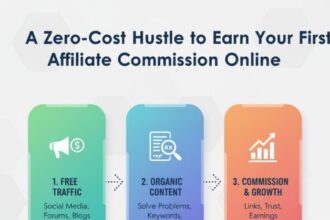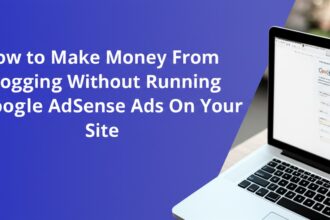My Business Was Invisible. Then I Learned Why Your Brand Needs a Strong Content Marketing Plan.
I was sitting on my living room floor, surrounded by what felt like a hundred little shipping boxes. It was midnight. And I was packing exactly zero orders.
My online store, the one I had poured my entire life savings and a frankly irresponsible amount of hope into, was a ghost town. I had this great product—hand-poured candles with unique scents—and I had convinced myself that was enough.
It wasn’t. Not even close.
I’d post on social media and get nothing. I’d run a tiny ad and watch my money disappear with nothing to show for it. It was a slow, quiet, soul-crushing failure. And the worst part? I had no idea why. It felt like I was running a shop behind a locked door, on a street no one ever walked down. I just kept thinking, “Why doesn’t anyone see me?” I didn’t realize it then, but my problem had a name. I didn’t understand why your brand needs a strong content marketing plan.
I didn’t even really know what “content marketing” was. To me, it sounded like some corporate, jargon-filled nonsense. Something for big companies with actual marketing departments. Not for me, a person who was currently debating whether eating cereal for dinner for the third night in a row was a cry for help.
But I was desperate. And desperation, as it turns out, is a great motivator for learning. So, I opened my laptop and fell down a rabbit hole so deep, I wasn’t sure I’d ever find my way out. But I did. And what I learned changed everything. Absolutely everything.
My First Steps Into the Weird World of Content
So there I was, ready to absorb all the knowledge the internet had to throw at me. My first impression? Abject terror.
It felt like trying to drink water from a firehose that was spraying a foreign language. The buzzwords alone were enough to make my head spin. SEO. CTA. KPI. Funnels. It was an alphabet soup of business-speak that felt so disconnected from my simple, heartfelt goal: getting people to enjoy my candles.
I felt like such an imposter. Who was I, a person whose main skill was melting wax, to try and understand this complex digital world? It seemed like you needed a business degree just to understand the introductory articles. I was so out of my league it was comical.
Drowning in a Sea of Acronyms
The language was the first big wall I hit. It felt intentionally obtuse, like a secret code designed to keep normal people out. And honestly? It worked.
I’d read a sentence like, “Leverage your top-of-funnel content to improve brand recall and drive MQLs,” and my brain would just fizzle out. It meant nothing to me. I was just a person trying to figure out what to post online, and it felt like I had stumbled into a NASA briefing by mistake.
This initial phase was just me, feeling really, really dumb. It was discouraging, to say the least. It made me feel like maybe I just wasn’t smart enough to run a business. A feeling I’m sure a lot of us have had.
My First Sad Attempt at “Content”
So what did I do? I panicked and just started… posting stuff. Randomly.
I thought “content” just meant “things.” Pictures of my candles. A post saying, “New scent alert!” Another one saying, “Don’t you just love candles?” It was thin. It was boring. It was, in essence, me just shouting “Buy my stuff!” into the digital wind.
Of course, it didn’t work. Why would it? I wasn’t giving anyone a reason to care. I wasn’t engaging with them. I had zero audience engagement because I was offering them nothing engaging.
And I had absolutely no SEO content strategy. I didn’t even really know what SEO was. I just knew it was something about Google. I was just throwing spaghetti at the wall, and none of it was sticking. It was a sad, lonely, spaghetti-covered wall. It was a total failure. But it was a necessary one. Because it forced me to realize that I wasn’t just doing it wrong. I was thinking about it wrong. Fundamentally.
Turns Out, a Lot of People Are Wrong About Why Your Brand Needs a Strong Content Marketing Plan
After my first few weeks of flailing and failing, I started to get a little bit cynical. I was tired of the gurus and the “5 easy steps” that were anything but easy. I started to read between the lines. And you know what I found?
A lot of the conventional wisdom is just plain wrong. Or, at the very least, it’s missing the entire point.
My deep dive into why your brand needs a strong content marketing plan became less about learning a set of rules and more about unlearning a bunch of bad ideas. It was a process of subtraction. And as I started to shed these misconceptions, things finally started to make a bit of sense. It was a relief, honestly. Like I could finally breathe.
The Big Myth: “It’s All About Selling”
This was the biggest one for me to get over. I thought the point of all of this was to directly sell my candles. Every blog post, every social media update, should be a direct line to a sale. Right?
Wrong. So, so wrong.
I spent a month trying this. I wrote a blog post called “Our Top 5 Best-Selling Candles.” I posted constantly on Instagram with “Shop Now!” links. I was in full-on salesperson mode. And it felt… gross. It felt needy and desperate. And my sales were as flat as they’d ever been.
What I finally realized is that a strong content marketing plan isn’t about selling. Not directly, anyway. It’s about earning. Earning trust. Earning attention. It’s about brand storytelling. It’s about telling a story so compelling that people want to buy from you, without you even having to ask. It’s a shift from “Buy my stuff!” to “Let me tell you why I do what I do.” A recent article from Forbes even highlighted that “consumers are more likely to buy from a brand that they feel a connection to,” which totally backs this up. It was a game-changer for me.
The Lie of the Linear Path
Another thing I got tangled up in was this idea of the “customer journey.” The way people talked about it made it sound like a straight line. Like a person sees your ad, clicks your link, reads your page, and buys your product. A neat, tidy little path.
So I tried to build this path. I made what I thought was the perfect product page. I tried to lead people directly from a post to a purchase. It was my version of customer journey mapping, and it was based on a complete fantasy.
The truth is, the customer journey isn’t a straight line. It’s a tangled, scribbly mess. It’s more like a maze. A person might see your Instagram post, forget about you for three weeks, then see a friend mention you, then Google your name, read your “About” page, leave again, and then finally, two weeks later, come back and buy something. It’s chaotic. And that’s okay. The point of content isn’t to force people down a path. It’s to put up interesting, helpful, beautiful signposts all over the maze, so that wherever they turn, they find something that makes them feel good about you and your brand.
“You Have to Be a Professional Writer/Filmmaker/Guru”
This one almost made me quit entirely. The myth that your content has to be “professional.”
I would see these other brands with these slick, polished blog posts and incredibly well-produced videos. And I would look at my own clumsy attempts and feel like a total amateur. I thought, “I can’t do this. I’m not a writer. I’m not a filmmaker.” I don’t have a studio or a fancy camera.
It was paralyzing. I would spend days trying to write one “perfect” blog post, only to delete it in a fit of self-doubt. I was so caught up in the idea of being “professional” that I wasn’t being anything at all.
But the truth is, you don’t have to be a professional. You just have to be a person. A real, honest-to-goodness person. People don’t connect with professionalism. They connect with personality. They connect with vulnerability. They connect with a real human being who is passionate about something. And I was passionate. I just had to give myself permission to show it, clumsiness and all.
The One Simple Idea That Finally Made “Content Marketing” Click
I was on the verge of giving up. For real this time. I was tired of feeling like I was faking it. Tired of talking to an empty room. Tired of feeling like a failure.
I was sitting on my floor, looking at my collection of unsold candles, and I had this thought: “Nobody cares about my candles.”
It was a bleak thought. But then, a second thought came right after it, like a little echo.
“…But maybe they would care about what I care about.”
And that was it. That was the whole “aha!” moment.
I had been trying to sell them a product. A thing. A scented piece of wax in a jar. But what if that wasn’t the point? What if the candle was just the souvenir? The physical object that represented something bigger?
I realized that I don’t just sell candles. I sell the feeling of a cozy, rainy afternoon. I sell a moment of peace at the end of a long day. I sell the memory of a walk in the woods. I sell nostalgia, and comfort, and a tiny bit of everyday magic. The candles are just the medium.
The product isn’t the content. The feeling is the content.
From Selling Products to Sharing a Passion
This single shift in perspective was like a key turning in a lock I didn’t even know was there.
Suddenly, I had so much to talk about. I wasn’t limited to just saying “Here’s a candle.” I could talk about why certain scents trigger memories. I could share my process of trying to capture the smell of an old library in a candle. I could tell the story behind a name.
I realized that good content marketing isn’t about hawking your wares. It’s about generously sharing your passion, your knowledge, your point of view. It’s about becoming a resource. This is where the idea of thought leadership came into play for me. Not in some grand, arrogant way. But in a small, genuine way. It’s about being the person who cares the most about this one specific thing, and sharing that care freely.
For the first time, I felt like I had a purpose. A direction. If you’ve ever felt stuck like I was, wondering what on earth you’re supposed to be talking about, you might find my other post, What I Learned When I Ran Out of Things to Say, helpful.
My Content as a Conversation Starter
Before this moment, I saw “content” as a monologue. Me, broadcasting a message out into the world.
But now, I see it as a conversation starter.
It’s me, putting an idea, or a story, or a question out into the world, and then genuinely listening to the response. It’s a way to invite people into my world. A way to say, “I’m obsessed with this. Are you, too?” It’s not about being an authority; it’s about being an enthusiast. And that’s a much more fun, and much less stressful, way to be.
My Personal, No-Nonsense Guide to Actually Doing This Stuff
So, after all that emotional turmoil and that one big breakthrough, what do I actually do now? I need to be really clear here: I am not a guru. This is not some foolproof, “get rich quick” system. It’s just my system. My cobbled-together, probably-doing-it-wrong-but-it-seems-to-be-working system. It’s what keeps me from losing my mind. And more importantly, it’s what finally got me out of my empty living room and into a world where I’m actually packing orders.
This is my personal guide. And it’s all built on that one simple idea: stop selling a product and start sharing a passion.
Step 1: I Gave My Content a Job.
This was a huge one for me. I stopped just creating content for the sake of it. Now, every single piece of content I create has a job to do. Maybe the job of an Instagram post is simply to make someone smile. Maybe the job of a blog post is to answer a common question so thoroughly that people feel like they’ve really learned something. Maybe the job of an email is to make my subscribers feel like they’re part of a secret club. I got this idea from a great article on HubSpot about content planning. By giving each piece a purpose, I stopped just making noise and started communicating.Step 2: I Stopped Shouting and Started Listening.
Instead of just guessing what people want, I started paying attention. I started measuring content ROI, not just in dollars, but in engagement. I looked at which blog posts got the most comments. Which emails got the most replies. Which social media posts sparked a real conversation. I use simple tools, mostly just the built-in analytics, but I look at them with a new perspective. I’m not just looking at numbers; I’m looking for clues about what my people actually care about. Then, I just do more of that. It’s that simple. It’s less about a grand strategy and more about a simple feedback loop.Step 3: I Made a ‘Menu’ of Content Ideas.
I used to stare at a blank screen in a cold sweat, thinking “What am I going to post today?” Not anymore. I created a simple “menu” of content types that I can choose from. Things like:The story behind a candle scent.
A peek into my messy, chaotic process.
A list of my favorite books to read by candlelight.
A post answering a question a customer asked me.
This gives me structure without being rigid. It helps me avoid that “blank page” paralysis. I talk about this method a lot in my other post, My Secret Weapon Against Creative Block.
Step 4: I Share My Stuff in More Than One Place.
This was a simple but powerful shift. I used to write a blog post and then just… hope people would find it. Now, I have a plan. I think about my content distribution channels. When I write a blog post, I’ll share it to my email list. I’ll turn the main points into a series of Instagram posts. I’ll make a short video talking about the core idea. I’ll share it on Pinterest. A great guide from Semrush on content distribution really opened my eyes to this. It’s about getting the most mileage out of the hard work you’ve already done. It’s working smarter, not harder. And I am all about that.
So, Where Does That Leave Me?
When I think about the person I was a few months ago, sitting on that floor surrounded by empty boxes, it feels like I’m thinking about a different person.
Am I a content marketing expert now? Absolutely not. Don’t ever ask me what a MQL is.
But I’m not lost anymore. I have a map. It might be a hand-drawn, slightly messy map with a few coffee stains on it, but it’s a map. And it works. My little business is growing. Slowly, steadily, and in a way that feels honest and sustainable. I’m packing orders now.
I went looking for the answer to why your brand needs a strong content marketing plan, and what I found was something so much simpler and more human than I ever expected. It’s not about selling. It’s not about funnels or jargon.
It’s about connection.
It’s about finding the thing you care about more than anyone else and then generously, passionately, and consistently sharing that care with the world. The marketing part… that’s just a side effect of making a real, human connection.
So, let me ask you this: What’s the story that only you can tell?



































